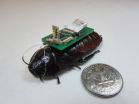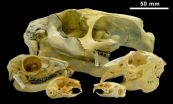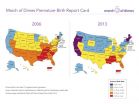Cockroach cyborgs use microphones to detect, trace sounds
2014-11-06
(Press-News.org) North Carolina State University researchers have developed technology that allows cyborg cockroaches, or biobots, to pick up sounds with small microphones and seek out the source of the sound. The technology is designed to help emergency personnel find and rescue survivors in the aftermath of a disaster.
The researchers have also developed technology that can be used as an "invisible fence" to keep the biobots in the disaster area.
"In a collapsed building, sound is the best way to find survivors," says Dr. Alper Bozkurt, an assistant professor of electrical and computer engineering at NC State and senior author of two papers on the work.
The biobots are equipped with electronic backpacks that control the cockroach's movements. Bozkurt's research team has created two types of customized backpacks using microphones. One type of biobot has a single microphone that can capture relatively high-resolution sound from any direction to be wirelessly transmitted to first responders.
The second type of biobot is equipped with an array of three directional microphones to detect the direction of the sound. The research team has also developed algorithms that analyze the sound from the microphone array to localize the source of the sound and steer the biobot in that direction. The system worked well during laboratory testing. Video of a laboratory test of the microphone array system is available at http://www.youtube.com/watch?v=oJXEPcv-FMw.
"The goal is to use the biobots with high-resolution microphones to differentiate between sounds that matter - like people calling for help - from sounds that don't matter - like a leaking pipe," Bozkurt says. "Once we've identified sounds that matter, we can use the biobots equipped with microphone arrays to zero in on where those sounds are coming from."
A research team led by Dr. Edgar Lobaton has previously shown that biobots can be used to map a disaster area. Funded by National Science Foundation CyberPhysical Systems Program, the long-term goal is for Bozkurt and Lobaton to merge their research efforts to both map disaster areas and pinpoint survivors. The researchers are already working with collaborator Dr. Mihail Sichitiu to develop the next generation of biobot networking and localization technology.
Bozkurt's team also recently demonstrated technology that creates an invisible fence for keeping biobots in a defined area. This is significant because it can be used to keep biobots at a disaster site, and to keep the biobots within range of each other so that they can be used as a reliable mobile wireless network. This technology could also be used to steer biobots to light sources, so that the miniaturized solar panels on biobot backpacks can be recharged. Video of the invisible fence technology in practice can be seen at http://www.youtube.com/watch?v=mWGAKd7_fAM.
INFORMATION:
A paper on the microphone sensor research, "Acoustic Sensors for Biobotic Search and Rescue," was presented Nov. 5 at the IEEE Sensors 2014 conference in Valencia, Spain. Lead author of the paper is Eric Whitmire, a former undergraduate at NC State. The paper was co-authored by Tahmid Latif, a Ph.D. student at NC State, and Bozkurt.
The paper on the invisible fence for biobots, "Towards Fenceless Boundaries for Solar Powered Insect Biobots," was presented Aug. 28 at the 36th Annual International IEEE EMBS Conference in Chicago, Illinois. Latif was the lead author. Co-authors include Tristan Novak, a graduate student at NC State, Whitmire and Bozkurt.
The research was supported by the National Science Foundation under grant number 1239243.
[Attachments] See images for this press release:

ELSE PRESS RELEASES FROM THIS DATE:
2014-11-06
Berlin, Germany (November, 2014) – A new study, which teamed cutting-edge engineering techniques with paleontology, has found that take-off capacity may have determined body size limits in extinct flying reptiles. The research simulated pterodactyl flight using computer modeling, and will be presented at the upcoming Society of Vertebrate Paleontology meeting in Berlin. Findings suggest that a pterodactyl with a wingspan of 12m or more would simply not be able to get off the ground.
Pterosaurs (commonly known as pterodactyls) were truly giants of the sky. With ...
2014-11-06
For ALMA's first observations in its new and most powerful mode, researchers pointed the antennas at HL Tauri — a young star, about 450 light-years away, which is surrounded by a dusty disc [1]. The resulting image exceeds all expectations and reveals unexpectedly fine detail in the disc of material left over from star birth. It shows a series of concentric bright rings, separated by gaps [2].
"These features are almost certainly the result of young planet-like bodies that are being formed in the disc. This is surprising since such young stars are not expected to ...
2014-11-06
Astronomers have captured the best image ever of planet formation around an infant star as part of the testing and verification process for the Atacama Large Millimeter/submillimeter Array's (ALMA) new high-resolution capabilities.
This revolutionary new image reveals in astonishing detail the planet-forming disk surrounding HL Tau, a Sun-like star located approximately 450 light-years from Earth in the constellation Taurus.
ALMA uncovered never-before-seen features in this system, including multiple concentric rings separated by clearly defined gaps. These structures ...
2014-11-06
Tiny extensions on cells, cilia, play an important role in insulin release, according to a new study, which is published in Nature Communications. The researchers report that the cilia of beta cells in the pancreas are covered with insulin receptors and that changed ciliary function can be associated with the development of type 2 diabetes.
Cilia are tiny extensions on cells and they are credited with many important functions, including transduction of signals in cells. Defects in cilia have been implied in several diseases and pathological conditions. Thus, scientists ...
2014-11-06
VIDEO:
A 10-day-old zebrafish gets its stripes over the next 30 days, one image taken a day.
Click here for more information.
Within weeks of publishing surprising new insights about how zebrafish get their stripes, the same University of Washington group is now able to explain how to "erase" them.
The findings – the first published Aug. 28 in Science and the latest in the Nov. 6 issue of Nature Communications – give new understanding about genes and cell behaviors ...
2014-11-06
Berlin, Germany (November, 2014) – Closely related groups can differ dramatically in their diversity, but why this happens is a fundamental question in evolutionary biology, dating back to Darwin's observation that a few hyper-diverse groups dominate the modern biota. One of the most extreme examples of this observation is found in the comparison of rodents (Rodentia) and rabbits (Lagomorpha). These two mammalian orders are sister groups, but while rodents have diversified to over 2000 living species and an enormous range of body sizes, lagomorphs (rabbits, hares, ...
2014-11-06
ATLANTA, GA (November 7, 2014) – Many people don't realize allergies and asthma go hand-in-hand, and about 90 percent of kids with asthma also have allergies. Even more important, when asthma is undiagnosed or poorly controlled, children are at risk for suffering difficult-to-treat allergic reactions to food.
According to a study presented at the American College of Allergy, Asthma and Immunology (ACAAI) Annual Scientific Meeting, a two and-a-half year-old girl in Pennsylvania suffered a life-threatening allergic reaction (anaphylaxis) to eating an orange – ...
2014-11-06
WHITE PLAINS, N.Y., Nov. 6, 2014 – The national preterm birth rate fell to 11.4 percent in 2013 – the lowest in 17 years -- meeting the federal Healthy People 2020 goal seven years early. Despite this progress, the U.S. still received a "C" on the 7th annual March of Dimes Premature Birth Report Card because it fell short of the more-challenging 9.6 percent target set by the March of Dimes, the group said today.
"Achieving the Healthy People 2020 goal is reason for celebration, but the U.S. still has one of the highest rates of preterm birth of any high ...
2014-11-06
WASHINGTON - Airport security agents using a new conversation-based screening method caught mock airline passengers with deceptive cover stories more than 20 times as often as agents who used the traditional method of examining body language for suspicious signs, according to new research published by the American Psychological Association.
In experiments spanning eight months, security agents at eight international airports in Europe detected dishonesty in 66 percent of the deceptive mock passengers using the new screening method, compared to just 3 percent for agents ...
2014-11-06
New Rochelle, NY, November 6, 2014—Screening large cell culture collections containing plant samples obtained from diverse geographic regions, climates, and soil and growing conditions for biological activity can reveal a wealth of natural compounds with potential applications for crop improvement and protection. The capability to do reproducible screening and genomic analysis of the more than 2,000 plant cell lines maintained in culture at the Institute of Cell Biology and Genetic Engineering, in Kiev, Ukraine is describe in an article in Industrial Biotechnology, ...
LAST 30 PRESS RELEASES:
[Press-News.org] Cockroach cyborgs use microphones to detect, trace sounds







